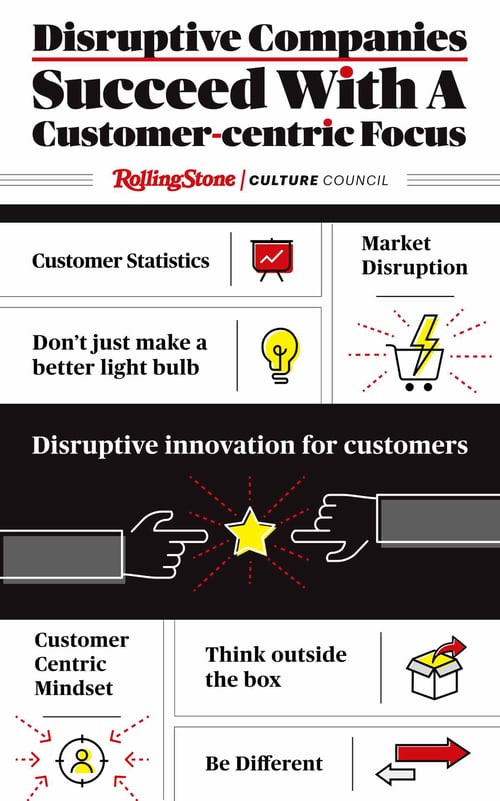
Creative leadership skills require new ways of using technology for their organizations. In many cases, this means using technology to solve customer problems that aren't being adequately addressed in other ways.
A customer-centric approach is all about putting the customer first. That means understanding customers' needs and desires and using that knowledge to guide your business decisions.
Technology plays a vital role in achieving this goal. By using data gathered from online interactions and social media, you can get a clear picture of what your customers want, as well as what they don't want. You can then use this information to develop new products or services that meet those needs, thereby gaining a competitive edge in the marketplace.
Technology can also be used to improve the customer experience, making it easier and more enjoyable to do business with your organization than with your competitors.
In short, technology gives creative leaders and your organizations opportunities to develop new, more customer-centric business models that disrupt existing markets. They may even lead to the creation of new markets that didn't previously exist.
But the real key is how you and the members of your team treat your customers.
Customer statistics
Let's start by looking at relevant customer statistics:
- 40% of consumers will recommend others not to buy from a business if they have had poor customer service experience
- 91% of customers who are unhappy with a brand will just buy from elsewhere without complaining
- 79% of consumers who shared complaints about poor customer experience online had their complaints ignored
- An average American tells 15 people when they experience poor customer service
- Around 54% of all consumers globally say they have higher customer service expectations than they did just one year ago
- 75% of brands report they are measuring customer engagement but cannot define what it is
- When it comes to making a purchase, 64% of people find customer experience more important than price
- The majority of adults - 66% - feel that valuing their time is the most important thing a company can do to provide a good customer experience
- 86% of millennials say they are influenced by negative reviews when purchase a product or service
- 75% of customers believe it takes too long to reach a live agent
- 90% of customers are influenced by positive reviews when buying a product
- Across the globe, 96% of consumers say customer service is an important factor in their choice of loyalty to a brand
- 89% of consumers have switched to doing business with a competitor following a poor customer experience
We could go on and on here, but the key point is this: customer service can make or break the success of a product or service, and ultimately, an entire organization.

Examples of market disruption
Alberto Brea, Executive Director of Engagement Planning at OgilvyOne Worldwide shared these thoughts in a social media post a couple of years ago:
- Amazon did not kill the retail industry. They did it to themselves with bad customer service.
- Netflix did not kill Blockbuster. They did it to themselves with ridiculous late fees.
- Uber did not kill the taxi business. They did it to themselves with limited numbers of taxis and fare control.
- Apple did not kill the music industry. They did it to themselves by forcing people to buy full-length albums.
- Airbnb did not kill the hotel industry. They did it to themselves with limited availability and pricing options.
- Technology by itself is not the real disruptor.
- Being non-customer centric is the biggest threat to any business.
Add to this the failure of Kodak, the mighty photography company whose employee, Steven Sasson, first discovered the technology behind digital photography. Kodak ignored this opportunity, didn't keep up with serving their customers, and ultimately failed.
Within the arts and culture industry, NFTs (non-fungible tokens) have been disrupting the art market, not only in visual art, but also in audio and video, and even in digital information. How do NFTs address customer concerns??
First, they provide some authenticity of certified ownership. Second, they create scarcity, thus ratcheting up the price and allowing digital art to be collected and traded like non-digital artwork. For customers, NFTs change the way art is defined and traded. For artists, NFTs automatically give them a piece of the monetary transaction.
Don't just make a better light bulb
The problem many organizations face is they choose "continual improvement" on an idea, rather than innovating influential - or even disruptive - change.
Don't just make a better light bulb, or bookstore, or hotel because there are customer problems associated with each of those standard models (the light bulb burns out too quickly, the bookstore doesn't have the book you want, the hotel doesn't have a room available when you need it).
To serve your audience better, as a creative leader, you and your team need to completely rethink the whole model.
For instance, whoever can completely change our use of power, instead of trying to improve existing batteries, will dramatically disrupt that market.
Whoever can solve the scheduling problems for air travel, instead of continually shuffling planes and crews, will dramatically disrupt that market.
| Your best bet to discover a network of supportive culture leaders and creators is with Rolling Stone Culture Council. Click here to see if you qualify. |
Disruptive innovations for customers
When developing a new way of doing something that is already being done, you and your team may need to be brave enough to step outside the "box-that-works." That box may work well enough, but there are likely problems with that box that drive people crazy. Not knowing what else to do or where else to turn, they just suck it up.
Your team members will have to break new ground, develop new rules and creative processes, and be willing to fail a few times. It's going to feel uncomfortable and even a bit scary. Innovating ideas to solve problems will almost always push you outside your comfort zone.
So, what's the best way to get started? How do you create market disruption? It all starts with a customer-centric mindset.
Creating a customer-centric mindset
The first step is to create a customer-centric mindset within your organization. This means making the customer the center of everything you do. Every decision, every action, and every process should be focused on providing the best possible experience for your customers.
This can be a challenge for organizations that are used to making decisions based on what's best for the company, rather than what's best for the customer. But it's essential if you want to create market disruption.
To create a customer-centric mindset, start by asking your team these questions:
- How will this decision or action impact our customers?
- What are we trying to achieve for our customers with this decision or action?
- What do our customers need or want from us?
- How can we make this experience better for our customers?
- What’s the best-case end result that would thrill our customers? How can we make the route to that end result simpler, faster, cheaper, and more exciting?
Once you have a customer-centric mindset, you can start to develop new ways of doing things that will create market disruption. But it's important to keep in mind that not all disruptions need to be big and flashy. Sometimes, the simplest solutions are the most effective.
Think outside the box
It's important to encourage your team to think outside the box and come up with new ideas. Look at things from a different perspective and see things that others may not see. One way to do this is to hold brainstorming sessions where everyone is encouraged to share their ideas, no matter how crazy they may seem.
Give your team the freedom to experiment and try new things. Encourage them to learn new skill sets or bring on new team members who have different abilities. Let them take risks and learn from their mistakes. Set up a team of "intrapreneurs" who have a green light to be as creative as possible.
Be different
To create market disruption, your organization needs to be willing to go against the grain and be different. Leadership is the ability to empower your team to do things that are unexpected and out of the norm. This can be a challenge for organizations that are used to doing things a certain way. But it's essential if you want to take the market in an entirely new direction.
If you're focusing on customers and audience, keep coming back to their needs and desires, the problems they face with the status quo. Go above and beyond to meet their needs and exceed their expectations. Be transparent with them and communicate with them in a way that is genuine and authentic.
Another way to be different is to offer something unique that your customers can't find anywhere else. This could be a unique product or service, or a unique customer experience. Whatever it is, it should be something that sets you apart from the competition and makes your customers want to come back to you time and again.
Being different is essential for creating market disruption. But it's not always easy. An important leadership quality is to have the courage to go against the grain and do things differently. But it's worth the effort if you can create a market-disrupting solution that meets the needs of your customers.
A customer-centric focus is key for creating market disruption. It's the best way to innovate in ways that create unique value. This means going above and beyond to meet needs and exceed expectations. It also means being transparent and communicating in an authentic way. And it means offering something unique that customers can't find anywhere else. These are just a few of the things you need to do to create market disruption. If you can start there, you'll be well on your way to success.